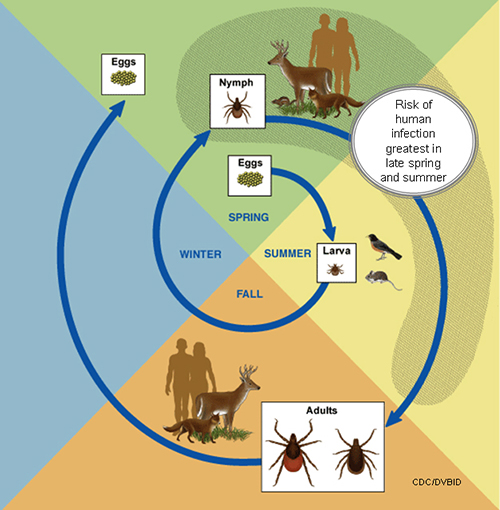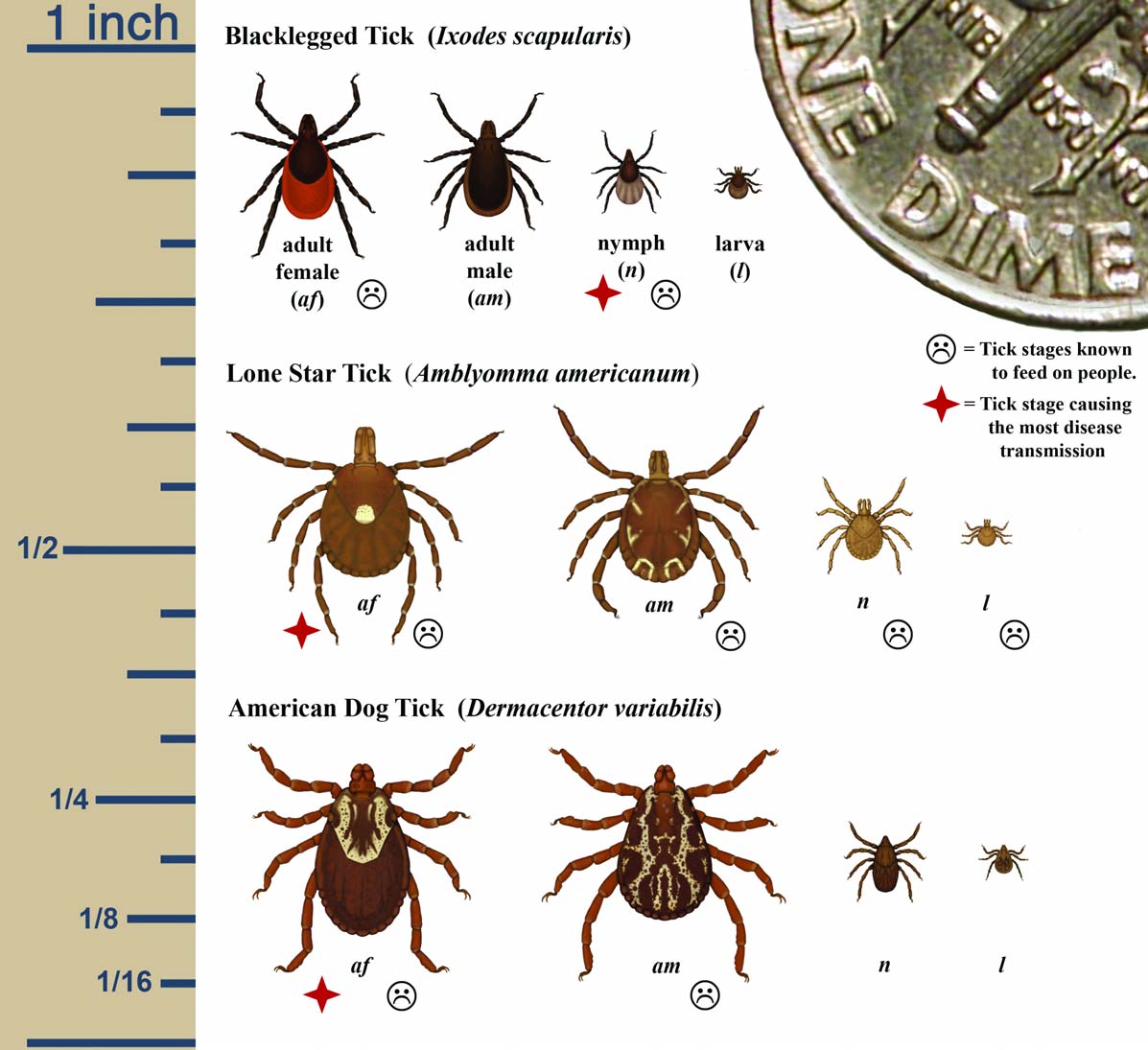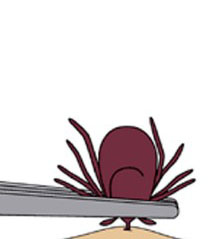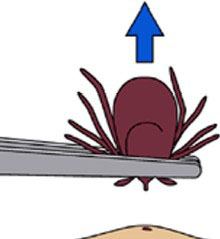Ticks
Prince William County Mosquito and Forest Pest Management does not perform any tick surveillance, control or testing. Please see below for useful tick information.
TICKS AND TICK-BORNE DISEASES IN PRINCE WILLIAM COUNTY
The following page is intended as an overview of tick biology, tick-borne diseases in Prince William County, and tips for protecting yourself from transmission of these diseases. For a more comprehensive guide to tick biology and a more in-depth look at the symptoms of each of the illnesses mentioned on this page, please visit the CDC's tick web portal. Mosquito and Forest Pest Management has also published a brochure on ticks and tick-borne diseases in the county, which can be viewed here.
WHAT ARE THE DEVELOPMENTAL STAGES OF TICKS?
Ticks have a complex, 2-3 year lifecycle. Most species go through four stages of development: egg, six-legged larva, eight-legged nymph, and adult. After they hatch, they require a bloodmeal to progress to each subsequent stage. Each species of tick exhibits preferences for different hosts, and they find hosts by detecting CO2, body odor, heat, and moisture.
Ticks do not drop from trees, fly, or jump; misconceptions that arise because they can often be found biting high up on the body. They must hitch a ride from tall grass or leaf litter and crawl their way up their host. Their preferred habitats include wooded and bushy areas with tall grass and leaf litter.
Once they have found a host, ticks will cut into the skin, anchor themselves, and feed for several days. While some diseases can be transmitted very quickly once a tick has attached, many require a longer period of attachment.
Tick larvae typically do not transmit disease, but both nymph and adult stages do. While ticks overwinter and can bite any time they are encountered throughout the year, their population density is seasonal and varies depending on which stage of development they are in. The risk of human infection with pathogens is highest in the late spring and summer, when nymphs are most dominant. While nymphs do not necessarily have a higher incidence of infection, they are smaller and more difficult to find on the body, and therefore may remain undetected for days.

WHAT TICKS DO WE HAVE IN PRINCE WILLIAM COUNTY AND WHAT DISEASES CAN THEY TRANSMIT?
There are four species of ticks in Prince William County that regularly bite people:
Lone Star Ticks: These are the most prevalent ticks in Prince William County. They are large, reddish brown, round ticks that feed on many different species of mammals. Females have a distinctive white spot on their back. All three active life stages will readily bite people, and they can be very aggressive and fast-moving in their pursuit of a bloodmeal, landing them on many different regions of the body. They can transmit ehrlichiosis, tularemia, and STARI (Southern Tick Associated Illness), and have additionally been implicated in the development of a serious red meat allergy.
Deer Ticks (also known as blacklegged ticks): Deer ticks are oblong, with darkly colored legs. Females have a reddish abdomen, while nymphs and males are darkly colored. Their preferred hosts are white-footed mice and other small rodents, and white-tailed deer, but nymphs and adults will also bite people. While bites to humans occur fairly rarely, a large percentage of the deer tick population is infected with one or more pathogens, making disease transmission in this species particularly concerning. In addition, they tend to bite in fairly inconspicuous areas, especially on the lower half of the body, and nymphs are extremely small and difficult to detect. They can transmit Lyme disease, babesiosis, and anaplasmosis, all very serious illnesses.
American Dog Ticks: Dog ticks are large, brown and cream colored ticks. Their preferred hosts are dogs, but larvae and nymphs will feed on smaller mammals, and adults will readily bite people. They often attach preferentially close to the hairline. They can transmit Rocky Mountain spotted fever, tularemia, and are the tick that most commonly induces tick paralysis. Tick paralysis is a rare condition, causing acute paralysis that can be reversed 24 hours after removal of the tick.
Gulf Coast Ticks: These ticks are a newly discovered import to Virginia and their prevalence is still being mapped out. Gulf Coast ticks are similar in appearance to dog ticks, and can transmit American tick bite fever, as well as a Rickettsia bacterium that causes symptoms similar to those seen in Rocky Mountain spotted fever.

WHAT CAN YOU DO TO PREVENT TICK BITES AND INFECTIONS?
Avoid tick habitats: Tick habitat includes wooded and bushy areas with tall grass and leaf litter. If you are walking through parks or wooded areas, walk through the center of hiking trails and pathways. Consider using repellents or clothing and camping gear treatments if you will be outside for extended periods of time.
Wear appropriate clothing: Wearing long sleeves and pants, and tucking pant legs into socks can prevent ticks from gaining access to your skin. Additionally, light colored clothing can make them easier to spot as they climb up you.
Shower and check yourself: Conduct a full-body tick check if you have been in a potential tick habitat. Pay particular attention to inconspicuous areas, including the back of the knee, armpits, back, waistline, behind the ear, and on the scalp. If you are a parent, check your children closely in these areas as well.
Examine gear and clothing: Ticks may not bite immediately, but instead hitch a ride back on anything they can grab ahold of. Closely inspect any camping gear or clothing that has been outside with you.
Tumble dry any appropriate gear: Clothing and gear can be tossed in the dryer on high heat for an hour to kill any ticks that may have come home with you.
Treat and inspect pets: Pets can also get sick from tick bites, as well as carry them in and out of the house. Dogs are susceptible to Lyme disease and other tick borne illnesses, and their dense fur can make it difficult to conduct a full inspection. Talk with your vet about an appropriate tick preventative for your animals. Take care not to apply inappropriate pesticides to or around cats; they can be extremely sensitive to some of the common tick treatments.
Use tick repellents and insecticides: Applying repellents containing between 20-30% DEET on exposed skin and clothing may repel ticks, although they can be difficult to deter with repellent alone. Permethrin or other pyrethroid based insecticides can be used to treat clothing and camping gear. These products are safe to use, but they are NOT made for applying to the skin. They are used to pre-treat clothing and gear, including pants, socks, boots, and tents. Follow all label instructions when applying these chemicals. Pre-treated gear and clothing can also be purchased at outdoor supply stores.
Create a tick-free yard: Remove leaf litter and keep grass mowed. Clear any tall brush or grass that you have on the edge of your property and construct fences to keep tick hosts such as deer and mice out of the yard. Keep any recreational equipment away from woodlines and create a three-foot wide barrier of wood chips between wooded areas and lawns to discourage ticks from migrating into the yard.
If you do get bitten: Remove and save the tick in a ziploc bag in the freezer. Monitor for any signs of illness; many tick-borne diseases have common symptoms, including fever, chills, aches and pains, and rashes. If you experience any of these after being bitten by a tick, take the preserved tick and visit your doctor immediately. Many tick-borne diseases respond well to rapid detection and treatment, but can be extremely dangerous if left untreated.
HOW SHOULD YOU REMOVE A TICK?
Tick removal is very simple, but there are many inappropriate home remedies that have cropped up. Do not burn the tick, cover it with petroleum jelly, or paint it with nail polish. These will only stress the tick out and may encourage it to empty the contents of its stomach into the bite wound, potentially increasing disease transmission.
Instead, grip the tick as close to the skin's surface as possible with a pair of fine tipped tweezers. Pull up with steady, even pressure until the mouthparts slide out. If the mouthparts break, they can still be removed with tweezers, but if left in, they will eventually be ejected by the immune system. Once the tick is out, clean the wound and your fingers thoroughly with rubbing alcohol or soap and apply a bandage. Tick bites can be extremely itchy and painful for weeks even if the tick was not attached long. Resist the urge to scratch the bite, or apply an anti-itch cream to the wound.


LYME DISEASE FAQ
What is Lyme Disease? Lyme disease is an infection transmitted by the deer tick (and some other Ixodes ticks), which can lead to serious, long-term neurological, cardiovascular, and joint problems if left untreated. Deer ticks infected with the Lyme disease bacterium are prevalent throughout Prince William County.
How is it transmitted? Tick larvae or nymphs feed on infected white-footed mice (one reservoir for the bacteria), and become infected. They can then bite people and transmit the bacterial infection. Nymphs are most likely to transmit Lyme disease due to their small size and elusive nature. The tick must be attached 36-48 hours to transmit the pathogen.
How is it treated? Lyme disease is caused by the bacterium Borrelia burgdorferi, and can thus be treated with a course of antibiotics. If caught early, the infection responds completely to antibiotics. Long-standing infections are very difficult to treat.
What are the symptoms? Initial symptoms include fever, headache, fatigue, and a characteristic bulls-eye skin rash called erythema migraines. The rash is present in only 70-80% of cases. Later complications can include arthritis, neuropathy, and encephalomyelitis.